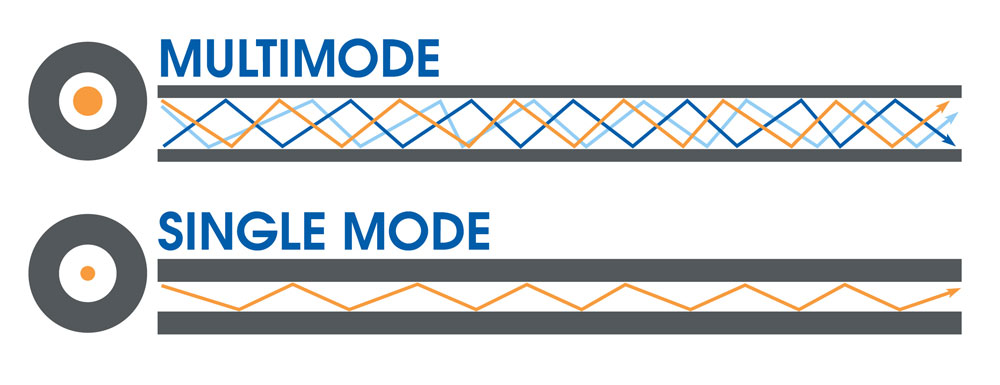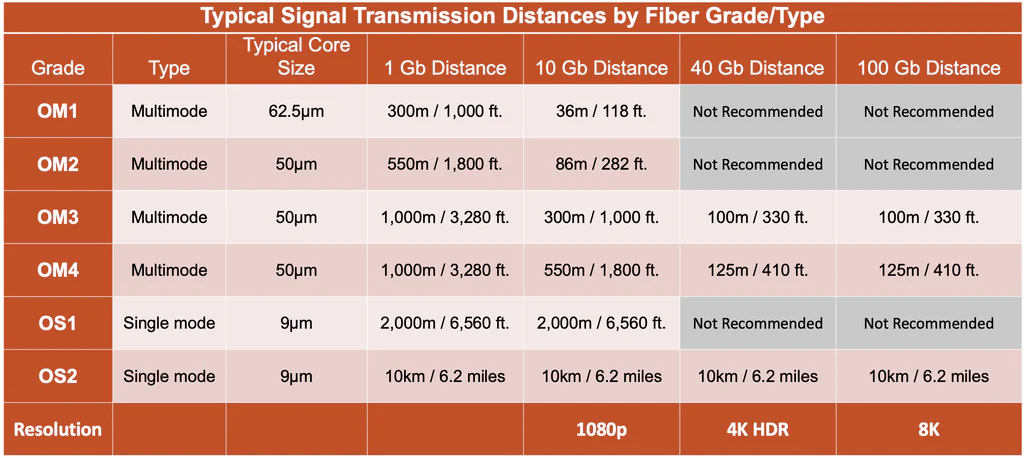How to identify single mode vs multimode fiber? What is my budget for Single mode Fiber vs. Multimode Fiber?
These are just a few questions you’ll need to ask yourself when choosing between single-mode and multimode fiber. Single-mode fibers provide a single pathway for light to travel and are defined by their small core size of approximately 8.3 µm. Multimode fibers, on the other hand, have various paths, or modes, in which light can travel through optical fiber. These core sizes are larger, ranging from 50 µm to 62.5 µm.
Single mode Fiber vs. Multimode Fiber, They look the same but quite different from many aspects, If you are an new users or buyers in fiber optic industry, This is a very beginning for fiber optic products. To solve this problems, Today we provide a brief description of the difference between the two, the similarities, as well as some common misconceptions about singlemode fiber and multimode fiber cables.

Let’s take a look at its core diameters between Single mode Fiber and Multimode Fiber,

Overview of Single mode Fiber vs. Multimode Fiber
| Feature | Single Mode Fiber (SMF) | Multimode Fiber (MMF) |
|---|---|---|
| Core Diameter | Approximately 8-10 microns | Approximately 50-62.5 microns |
| Mode of Transmission | a single light mode | Supports multiple light modes, allowing multiple paths for light |
| Bandwidth | Higher bandwidth | Lower bandwidth than SMF |
| Distance | Suitable for long-distance transmission, capable of traveling up to 100 km without significant signal degradation | Suitable for short to medium distances, typically up to 550 meters for 10GbE, but can vary depending on the grade |
| Wavelength | typically 1310 nm 1490nm or 1550 nm | Uses shorter wavelengths, typically around 850 nm or 1300 nm |
| Data Rate | Capable of very high data rates (10 Gbps to beyond 100 Gbps) over long distances without repeaters | Generally supports lower data rates than SMF over its effective distance |
| Application | Ideal for telecommunications, cable television, and long-haul networks | Primarily used in data centers, local area networks (LANs), and within buildings |
| Installation Cost | Higher initial cost due to the precision required for splicing and the cost of electronics | Lower initial cost due to easier handling and the lower cost of associated electronics |
| Connector Type | Typically uses LC, SC, FC, or ST connectors | Also uses LC, SC, FC, or ST connectors, but with a different polishing style |
| Attenuation | Lower attenuation, allowing for longer distances without amplification | Higher attenuation compared to SMF, limiting its effective distance |
| Color Coding | Typically yellow | Typically orange, aqua, or lime green, depending on the type (OM1, OM2, OM3, OM4, OM5) |
Typical Signal Transmission Distances by Different Fibers

How to Choose between Single Mode Fiber & Multimode Fiber?
When comparing Single Mode Fiber (SMF) to Multimode Fiber (MMF), it’s essential to delve into several critical aspects to understand their distinctions, applications, and optimal use cases. Here’s a detailed instruction that breaks down the differences from various perspectives:
Wavelength
- SMF generally operates at longer wavelengths, typically 1310 nm or 1550 nm, which are optimal for traveling long distances.
- MMF is optimized for shorter wavelengths, around 850 nm or 1300 nm, which works well for its design to handle multiple light modes over shorter runs.
Bandwidth
- SMF provides a higher bandwidth capacity due to the single light path, which eliminates modal dispersion and allows for data to be transmitted over longer distances without degradation.
- MMF offers lower bandwidth compared to SMF, as the presence of multiple light modes can lead to modal dispersion and limit the transmission distance before signal quality drops.
Attenuation
- SMF experiences lower attenuation rates, meaning it can transmit signals over longer distances with minimal signal loss.
- MMF typically has higher attenuation levels, making it more suitable for shorter distances due to the signal degradation over length.
Distance
- SMF is capable of supporting transmission over distances of up to 100 km without significant signal degradation, making it ideal for long-haul communications.
- MMF is designed for shorter distances, typically up to 550 meters for 10GbE applications, but can extend to 2 km for certain types and applications.
Cost
- SMF tends to be more expensive due to the precision required in manufacturing and the specialized equipment needed for sending and receiving signals.
- MMF is generally less costly in terms of both the fiber and the associated electronics, making it a budget-friendly option for short-distance applications.
Application
- SMF is best suited for long-distance telecommunications, backbone installations in networks, and situations where high bandwidth over long distances is required.
- MMF is typically used within data centers, for short-range communication links, and in applications where high data rates are needed over moderate distances.
Conclusion
The selection of singlemode or multimode fiber optic cabling is based on whether it will need to be installed over a long (approximate maximum distance, 6 miles) or a short distance (approximate maximum distance, 1,800 feet).
While each type of fiber optic cable has its pros and cons, including installation cost, bandwidth, brightness, signal loss, etc., there is one constant that should be remembered, and that is not to mix them. Singlemode only works with singlemode cables, connectors, and electronics, and the same goes for multimode cables.
Discover Fiber Optic Solution for Your Business with Bativ
Whether you need single mode or multimode fiber optic products, work with an experienced fiber optic connectivity company like bativ. We can deliver high-quality fiber termination box, fiber patch cables, plc splitters, fiber splice closures and more.
We’ll guide you on the best types of material and products for your needs and budget. we’re here to help. Get in touch today to discuss your requirements.
To learn more about the this topics, You can refer to the below links too.
- https://jonard.com/blog/singlemode-fiber-vs-multimode-fiber-what-difference
- https://community.fs.com/article/single-mode-cabling-cost-vs-multimode-cabling-cost.html
- https://learn.aflglobal.com/home/single-mode-vs-multimode
- https://www.tlnetworx.com/blogs/news/single-mode-vs-multimode-fiber-whats-the-difference